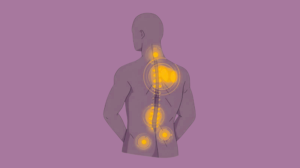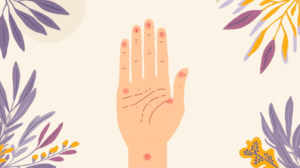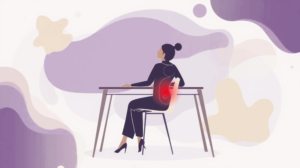Imagine this: enduring a never-ending meeting or driving for an extended time, only to receive a sudden, sharp pain in the lower back of your spine. That annoying ache in the area close to your tailbone, or coccyx, can even make daily activities uncomfortable. For certain individuals, coccyx cushions are a convenient fix to end this issue. You might have heard lots of things about these pillows, some will say they are fantastic, some will advise that they can be more damaging than helpful. But then there is so much mixed advice online. How do you know you can believe it?
Tailbone pain or coccydynia affects people of any age and occupation. If you sit in an office all day where you are confined to a chair, you spend long hours driving on the roads, you’ve had a baby and are recovering from childbirth, or you’re an athlete attempting to heal an injury, coccyx cushions are most often prescribed to alleviate the pain. There is much myth and misinformation about these cushions. This article tries to dispel the misconceptions by discussing the most prevalent myths, reviewing scientific research, and providing a practical guide on how to choose and use coccyx cushions properly. At the end of it all, you will know better what works and what does not work, so you can make the right choices for your comfort and well-being.
What Are the Most Common Myths About Coccyx Cushions?
Myth 1: Coccyx Cushions Are Only for the Elderly
Many people believe coccyx cushions are designed only for older adults. This myth likely stems from the fact that bone density loss and degenerative spine conditions tend to increase with age, making tailbone injuries more common among the elderly. While it is true that older adults may experience coccyx pain more frequently, this does not mean coccyx cushions are limited to their use.
In reality, tailbone pain affects a broad range of people. Young adults who spend prolonged hours sitting for work or study often develop pressure sores or poor posture-related pain around the coccyx. Gamers, drivers, office workers, and postpartum women commonly experience tailbone discomfort. Postural issues, trauma, or repetitive strain can cause coccydynia irrespective of age. Coccyx cushions help redistribute pressure and support proper sitting posture for anyone experiencing tailbone pain or looking to prevent it [1].
Myth 2: They Cure Tailbone Pain Permanently
It is a misconception that tailbone pain can heal for good with a coccyx cushion alone. Sadly, there is no one cushion that can ever cure long-standing pain for good. Tailbone pain may have a number of possible causes, such as coccydynia (coccyx inflammation), fracture, dislocation, or referred pain by the lumbar spine or pelvic structures.
Though coccyx pillows can relieve pressure and make sitting more comfortable, long-term relief usually needs the underlying cause to be addressed. Treatment is possible through physical therapy, medication, lifestyle modification, or in extreme cases, surgery. Coccyx pillows are a help and offer symptomatic relief but are no magic cure [2].
Myth 3: All Cushions Work the Same
Not all coccyx cushions are created equal. Materials, shapes, and thicknesses vary widely across brands and models. Some cushions use memory foam, which molds to the body’s shape, providing contouring support. Others incorporate gel layers to improve cooling and reduce heat build-up. Some models use air-filled chambers that allow adjustability for firmness.
Scientific studies show that the cushion’s material and design impact how well it distributes pressure and supports spinal alignment. For example, U-shaped cushions with a cut-out under the tailbone are designed to relieve direct pressure, whereas flat or donut-shaped cushions may not provide the same level of relief and can sometimes exacerbate discomfort [3].
Choosing the right cushion depends on individual needs, sitting habits, and the nature of tailbone pain.
Myth 4: Using One Can Make Your Pain Worse
Others stay away from coccyx cushions because they are afraid that they will worsen their pain. This is not totally without basis. Bad cushion design or application can lead to more pain. Cushions with no U-shaped cut-out, for instance, can apply more pressure onto the tailbone rather than alleviating it. Similarly, too firm or too soft cushions can lead to abnormal posture, which can lead to muscle strain.
But when well chosen and applied in the right manner, coccyx cushions tend to minimize pain through weight reduction and provision of support for spinal alignment. The essence here lies in selecting medically approved cushions with ergonomic design and applying them as part of an overall pain management strategy [4].
Myth 5: You Don’t Need One If You Have a Soft Chair
They all believe a soft chair will protect the tailbone, therefore they don’t need a coccyx cushion. Soft chairs are nice to sit in initially, but they’re too soft to provide proper spinal alignment. Sitting for extended periods of time on soft surfaces can cause the pelvis to tilt back, leading to flattening the natural lumbar curve and placing pressure on the tailbone.
A well-crafted coccyx cushion ensures even body weight distribution and takes pressure off the coccyx to encourage proper posture. Unlike regular cushions or sofa pillows that may compress unevenly, a well-crafted coccyx cushion provides comfort and spine health [5].
Myth 6: Memory Foam Is Always the Best Choice
Memory foam is also popular due to its contouring nature and pressure point relief. It is not always the best choice for everyone, however. Memory foam pillows become hot, which can cause sweat and discomfort with heavy use.
Hybrid or gel-infused pillows are cooling in nature and can provide firmer support in the long term. It has been observed that the preference between memory foam and alternatives like gel or air pillows depends on body weight, activity level, and comfort preference [6].
Myth 7: Coccyx Cushions Are Uncomfortable and Bulky
Older designs of coccyx cushions were often bulky and difficult to carry around. Today, many modern cushions are lightweight, slim, and ergonomically designed for portability and comfort. Some models are foldable, allowing easy transport for travel or office use without sacrificing support.
Comfort depends largely on selecting the right cushion for your body and usage. Reviews and ergonomic certifications can help guide this choice [7].
What’s Actually True About Coccyx Cushions?
1. They Help Alleviate Pressure from the Tailbone
The primary function of a coccyx cushion is to redistribute body weight away from the tailbone, reducing direct stress on the coccyx. This decreases pressure that can aggravate inflammation or injury, providing relief during prolonged sitting.
Biomechanical studies using pressure mapping have demonstrated significant reduction in coccyx pressure when sitting on U-shaped cushions compared to flat seats [8].
2. Ideal for Prolonged Sitting and Injury Recovery
People recovering from coccygeal fractures or dealing with coccydynia often find daily use of coccyx cushions beneficial. The cushions reduce pain during activities such as office work, long drives, or wheelchair use by supporting proper posture and minimizing pressure [9].
3. Correct Cushion Design Matters
The shape and design of the cushion are crucial. Cushions with a U-shaped or wedge cut-out beneath the tailbone prevent direct contact and pressure. Ergonomic designs that promote an anterior pelvic tilt help maintain the natural lumbar curve, reducing muscular strain.
Clinical research supports the superiority of ergonomic cushions over traditional flat or donut cushions in relieving coccyx pain [10].
4. They Support Better Sitting Posture
Using coccyx cushions encourages better sitting posture by promoting pelvic alignment. This reduces compensatory muscle tension and spinal misalignment that contribute to pain.
A 2020 biomechanical study found that cushions with appropriate cut-outs encouraged an anterior pelvic tilt, supporting the lumbar spine’s natural curvature and reducing fatigue [11].
5. They’re Useful Across Age Groups and Lifestyles
Coccyx cushions benefit a wide demographic, from students and office workers to postpartum women and drivers. They provide preventive support for those with sedentary habits as well as therapeutic aid for those with existing coccyx pain [12].
How Do You Choose the Right Coccyx Cushion?
Material Types: Gel, Memory Foam, Air-Filled
Memory foam contours to your shape but may retain heat. Gel cushions offer cooling and firm support. Air-filled cushions allow adjustable firmness and portability. Your choice should depend on duration of use, comfort preferences, and environment [13].
Size and Portability
For office or travel, lightweight and foldable cushions are best. Make sure the cushion fits your chair and allows comfortable leg positioning. Thickness should be enough to provide relief without raising you too high [14].
Cut-Out Design and Shape
Look for U-shaped or V-shaped cut-outs that remove pressure from the coccyx. Wedge shapes can tilt the pelvis forward to maintain spinal alignment. Avoid flat or donut-shaped cushions that do not adequately relieve pressure [15].
Medical Recommendations and Certifications
Choose cushions tested or recommended by orthopedic specialists. Certifications indicate compliance with ergonomic standards and pressure-mapping validation, ensuring safer, more effective support [16].
When Should You Use or Avoid Coccyx Cushions?
Post-Surgery or Fracture
Cushions can ease pain and protect healing tissue after lower spine or pelvic surgery. Always consult your surgeon before use [17].
Chronic Coccyx Pain
For chronic coccydynia, cushions provide daily symptomatic relief but are usually part of a multi-modal treatment plan including physical therapy and medication [18].
Pregnancy/Postpartum Use
Postpartum women often suffer tailbone pain due to childbirth trauma. Cushions offer safe, gentle relief during breastfeeding or prolonged sitting [19].
Situations Where a Medical Check Is Needed First
Avoid cushions if pain is due to infection, malignancy, or undiagnosed fractures. Using cushions without a proper diagnosis may mask serious conditions and delay treatment [20].
Final Thoughts: Don’t Let Myths Decide Your Comfort
Coccyx cushions are valuable tools for managing tailbone discomfort when chosen carefully and used properly. They offer real benefits by redistributing pressure, supporting posture, and improving sitting comfort. However, they are not miracle cures.
Separating fact from myth empowers you to make decisions based on your symptoms and medical advice. The right cushion may not cure your pain but can make daily sitting much more bearable. Always consult healthcare professionals for persistent or severe pain and combine cushion use with active self-care strategies for the best outcomes.
Frequently Asked Questions:
1. Do coccyx cushions actually work for tailbone pain?
Yes, scientific studies show that ergonomic coccyx cushions reduce pressure and improve posture, helping relieve pain in many cases [8].
2. Can sitting on a coccyx cushion worsen back or hip pain?
If the cushion is poorly designed or used improperly, it can cause discomfort or worsen symptoms. Choose a medically approved design and adjust usage as needed [4].
3. Are coccyx cushions only needed for hard chairs?
No. Even soft chairs can cause poor posture and pressure issues. Cushions help distribute weight and improve alignment on all seating types [5].
4. How long should I use a coccyx cushion daily?
Use as needed during prolonged sitting. Gradually increase duration while monitoring comfort and pain levels. Consult a healthcare provider for personalized advice.
5. Can coccyx cushions help during pregnancy?
Yes, they can provide relief from tailbone pain related to pregnancy and postpartum recovery by reducing pressure and supporting posture [19].
References:
- https://www.ncbi.nlm.nih.gov/pmc/articles/PMC7104212/
- https://www.mayoclinic.org/diseases-conditions/coccydynia/symptoms-causes/syc-20371356
- https://pubmed.ncbi.nlm.nih.gov/24567118/
- https://www.ncbi.nlm.nih.gov/pmc/articles/PMC5605287/
- https://www.ncbi.nlm.nih.gov/pmc/articles/PMC4651493/
- https://pubmed.ncbi.nlm.nih.gov/26371744/
- https://www.sciencedirect.com/science/article/abs/pii/S0967586819305734
- https://pubmed.ncbi.nlm.nih.gov/25657350/
- https://www.ncbi.nlm.nih.gov/pmc/articles/PMC6786163/
- https://pubmed.ncbi.nlm.nih.gov/32046803/
- https://pubmed.ncbi.nlm.nih.gov/32614207/
- https://www.ncbi.nlm.nih.gov/pmc/articles/PMC7085331/
- https://www.ncbi.nlm.nih.gov/pmc/articles/PMC6982724/
- https://www.ncbi.nlm.nih.gov/pmc/articles/PMC6543319/
- https://pubmed.ncbi.nlm.nih.gov/29178567/
- https://www.orthobullets.com/spine/3032/coccyx-injuries
- https://www.ncbi.nlm.nih.gov/books/NBK507884/
- https://www.ncbi.nlm.nih.gov/pmc/articles/PMC6746787/
- https://pubmed.ncbi.nlm.nih.gov/30614356/
- https://www.ncbi.nlm.nih.gov/pmc/articles/PMC5598473/






















